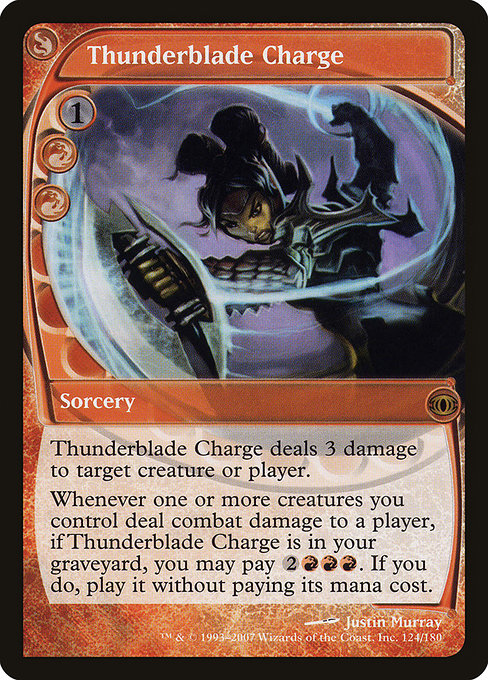
Image courtesy of Scryfall.com
Thunderblade Charge and the Heartbeat of Red
Red has always been about consequence in the moment: a swift, loud response to threats, a spark that sets the board ablaze, and a willingness to gamble with reward and risk in equal measure. Thunderblade Charge is a perfect miniature manifesto of that philosophy. A scarlet snap of power that yet hides a sly, long-game engine, it embodies red’s love of direct impact while sneaking in a backdoor to re-use that power later. In the Future Sight era, where Wizards teased possible futures with unusual frames and curious mechanics, this card stands out as both a punchy burn spell and a reminder that red can improvise, improvise again, and still come out swinging. 🧙♂️🔥💎⚔️
Direct damage as the spine of red's strategy
The card costs {1}{R}{R} for a solid 3 damage to any target. That “any target” clause is a hallmark of red’s flexibility: you can burn a creature, finish a stuck opponent, or finish off a planeswalker. It’s not just about shaving life totals; it’s about tempo—the ability to push through threats when the battlefield looks crowded with blockers or obstacles. In this sense, Thunderblade Charge is a quintessential red tool: a clean, affordable strike that can swing the momentum of a game in a single moment. 🔥
The clever engine: recasting from the graveyard
Where red often leans on explosive bursts, this spell gives you a second life at the exact moment you’ve done real damage. The second half of Thunderblade Charge reads as a nod to a raucous, reckless resilience: "Whenever one or more creatures you control deal combat damage to a player, if this card is in your graveyard, you may pay {2}{R}{R}{R}. If you do, you may cast it without paying its mana cost." That is red logic distilled into one line. If you’re pressuring a player and manage to ding them with creatures, you unlock a way to bolt-shock them again—without tapping extra mana. It’s a mechanical wink to red’s “blow it up and do it again” ethos, a concept that makes even a casual red deck feel like it’s teetering on the edge of a big, flashy comeback. 🪄⚡
Practical synergy and deck-building feel
In practice, Thunderblade Charge rewards players who craft around quantity of damage and board presence. The graveyard-recast option encourages you to design with redundancy in mind: multiple creatures that can deal combat damage to a player, or favorable circumstances where you can maximize damage in a single combat phase. If your strategy leans into red’s chaotic tempo—cheap plays, rapid pressure, and a willingness to risk the long game for a single blow—this spell can sit at the heart of a late-game surprise. The card’s design also echoes red’s capacity to flexionally recycle effects: you’re not simply burning the opponent; you’re building a narrative of momentum where the spell’s power can re-emerge from the graveyard like a phoenix bolt. 🎲🎨
Flavor, set context, and the artful spark
Future Sight was Wizards of the Coast’s laboratory for “what could be,” a set that mapped myriad twists on familiar mechanics and small-but-decisive design experiments. Thunderblade Charge fits that climate: a straightforward, aggressive effect with an unexpected, delayed payoff that echoes red’s predilection for speed and improvisation. The artwork by Justin Murray channels the raw electricity implied by its name—thunder, blades of red light, and a moment of decisive action captured in a single frame. The piece invites you to feel the instant, to hear the crack of the bolt, and to sense that red’s power is most potent when you’re prepared to seize the initiative the moment you draw into that second chance. 🎨⚔️
Red’s magic isn’t just about the big swing; it’s about turning a single moment into a surge that reshapes the entire game. Thunderblade Charge embodies that perfectly: a tiny spell that can double as a comeback engine if you’re willing to gamble on its graveyard heartbeat.
Value, playability, and the collector’s lens
Thunderblade Charge lands in Future Sight as a rare, with both nonfoil and foil printings. In current markets, its foil variant sits at a modest premium relative to its core price—reflecting its status as a beloved throwback for players who enjoy red’s immediate impact and nostalgic “blast from the future” flavor. The card’s EDH/Commander footprint is modest: it can slot into red-heavy lists that lean on damage-based interaction, but you’ll rarely find it a staple in top-tier competitive builds. Its EDH recency is pleasantly quirky, often appearing as a spicy include in meme-spirited or themed red decks and in casual beater stacks. The numerical data lines up with a card that’s cherished for its design flair and its fun, late-game potential, rather than as a price-driver staple. 💎🔥
Practical takeaways: building around the charge
- Pressure and recast potential: Use Thunderblade Charge in decks that push multiple small threats across the battlefield. If you can trigger its graveyard ability, you’ve effectively created a second a-time-damage line that can surprise an unsuspecting opponent.
- Red’s resilience: The card demonstrates red’s willingness to invest a resource to gain tempo back later. Time your assault so that combat damage lines up with your graveyard window for maximum payoff.
- Semi-legacy feel in a modern frame: While Future Sight is far in the past, the card’s logic scratches that itch for “what-if” play. It’s a flavorful nod to past and future—perfect for casuals and spice-focused decks in Modern-legal environs. 🧭
Cross-promotional note
If you’re planning a productive session, you might also want a sturdy surface to map out your next moves. This Neon Gaming Non-Slip Mouse Pad is a stylish companion for intense thinking and table-spanning battles alike. It pairs nicely with a red deck’s quick decisions and the thrill of a well-timed burn—perfect for long evenings spent strategizing while you watch the bolt land.